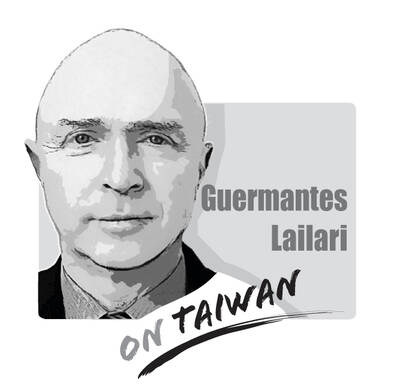From Alibaba Group Holding Ltd to Tencent Holdings Ltd, China’s largest companies are once again at the center of a market storm, spurred by speculation that Beijing is readying another assault on the world’s biggest Internet arena.
Three of China’s most valuable businesses — Alibaba, Tencent and Meituan — shed more than US$100 billion in the span of three turbulent days last week. It is a remarkable reversal from just a week earlier, as investors such as Berkshire Hathaway Inc chairman Charlie Munger spotted bargains among China Tech Inc after a US$1.5 trillion sell-off last year.
Macquarie Group Ltd issued a report this month headlined “peak crackdown.”

Illustration: Yusha
Now, investors are frantically attempting to parse a series of events that suggest Beijing is again preparing to rein in its giant private sector.
As companies report their earnings, their executives are likely to face questions about Beijing’s intentions for a sector subjected last year to unprecedented regulatory curbs and punishments, after Chinese President Xi Jinping’s (習近平) administration launched a “common prosperity” campaign to curb tech-sector excesses and force them to share the wealth.
The bloodletting began on Feb. 18, when the top state economic planner demanded Meituan and its peers lower the fees they charge restaurants in regions hit by the COVID-19 pandemic.
On Monday last week, a pair of unverified online posts that went viral said that Tencent — which weathered last year’s onslaught better than most — was facing a major regulatory crackdown, forcing its public relations chief into an unusually aggressive denial.
Later that day, Bloomberg reported that Beijing had ordered state-run firms to report their exposure to Jack Ma’s (馬雲) Ant Group Co — the hardest-hit firm in a year-long government campaign against “disorderly capital.”
“The events of the past 48 hours are a wake-up call that regulation isn’t finished,” said Michael Norris, an analyst with Shanghai-based consultancy AgencyChina. “We are going to be in a situation where the regulation and the slowdown in China’s economy happen side by side. It is going to be challenging for businesses that rely on consumers and merchant advertising to be able to make this year’s numbers.”
While many investors were counting on an end to the relentless regulatory pressure, fundamental questions remain about the ability of China’s tech giants to resume the growth they had enjoyed during a decade of near-unfettered expansion.
The shell-shocked industry had been expected to tread more cautiously this year than ever before — curtailing the hiring and acquisition sprees of years past, for one.
Didi Global Inc is preparing to reduce its headcount by as much as 20 percent ahead of its Hong Kong initial public offering, Bloomberg News reported earlier this month.
In response to online posts alleging Weibo Corp is firing a wave of people, the company said in a statement this month that it has since the beginning of the year started to readjust its businesses, allocating some staff to new roles before letting them go.
“The golden period of Chinese Internet is probably already behind us,” BNP Paribas Asset Management investment specialist Jessica Tea said. “That said, we believe the peak of the regulatory intensity is probably behind us in this cycle, as we move from policy normalization to growth normalization.”
Now, the demands placed on Meituan and food delivery peers such as Alibaba’s Ele.me suggest they are also getting pressed into national service, with uncertain longer-term implications.
The move to cut food delivery fees shows Beijing plans to enlist wealthy private firms to relieve the burden of smaller businesses hard-hit by China’s economic slowdown and its “COVID zero” strategy, Goldman Sachs analysts led by Ronald Keung wrote last week.
It is intended “to help companies in affected industries overcome the impact of COVID-related challenges by lowering their costs,” they wrote.
While it might affect the short-term profitability of Meituan and Alibaba’s loss-making Ele.me, the analysts said that they “see no long-term impact on Meituan’s business.”
The risks to growth are especially prominent at Alibaba, which last year swallowed a record US$2.8 billion fine after regulators forced it to end certain merchant exclusivity practices that allegedly helped it one-up rivals.
The regulatory assault has cut the company’s market value from US$858 billion in October 2020 to about US$310 billion.
Its outlook is already challenging.
Analysts forecast that revenue rose just 11 percent in the December quarter, by far the slowest rate of growth since it went public in 2014.
Alibaba’s operating margin slipped from 30.4 percent in 2017 to 10.7 percent in the twelve months ended September last year, pressured by new competitors and softening economic growth.
The firm has seen videostreaming platforms Douyin — the domestic sibling to ByteDance Ltd’s TikTok — and Kuaishou Technology draw business away from its Taobao and Tmall marketplaces.
To make matters worse, its top online influencer merchant, Viya, got caught up in a tax evasion scandal.
The dimming macroeconomic picture and overall challenging environment for global equities remain headwinds to Tencent and China Internet peers seeking a rebound from last year’s rout, but trends could brighten as the second half of the year approaches. Chinese economic stimulus, along with easing comparables from a year earlier, could be enough to stir a pickup after June, Bloomberg Intelligence analysts Matthew Kanterman and Tiffany Tam said.
In 2020, Alibaba hired more people than Silicon Valley giants Alphabet Inc, Meta Platforms Inc, Microsoft Corp, Netflix Inc and Tesla Inc combined. It more than doubled its number of employees in the 12 months ending March last year to 251,462, a total boosted in part by the takeover of the nationwide chain Sun Art Retail Group in October 2020, but it then added only another 7,000 in the following six months.
Tencent’s most recent report in June last year also showed its hiring pace slowing.
The waning fortunes of China’s Internet giants coincide with a reassessment under way in Silicon Valley, as the pandemic fades and takes the COVID-19-driven surge of Internet activity with it.
Facebook’s parent company posted its first-ever decline in user numbers, while Shopify Inc is warning of a slowdown.
At Tencent, revenue is expected to grow 9 percent for the fourth quarter, the slowest pace since its 2004 listing. That is after appetite for ads was dented by stricter privacy rules and a suspension of new game approvals that has dragged on for more than six months.
The company’s margins are already under pressure as the WeChat operator is now counting on overseas markets to spur gaming growth while devoting more resources to arenas such as the cloud and fintech.
“Bottom line, this policy pivot is real,” said Wai Ho Leong (梁偉浩), strategist at Modular Asset Management in Singapore, “and unlikely to soften any time soon.”

There is much evidence that the Chinese Communist Party (CCP) is sending soldiers from the People’s Liberation Army (PLA) to support Russia’s invasion of Ukraine — and is learning lessons for a future war against Taiwan. Until now, the CCP has claimed that they have not sent PLA personnel to support Russian aggression. On 18 April, Ukrainian President Volodymyr Zelinskiy announced that the CCP is supplying war supplies such as gunpowder, artillery, and weapons subcomponents to Russia. When Zelinskiy announced on 9 April that the Ukrainian Army had captured two Chinese nationals fighting with Russians on the front line with details
Within Taiwan’s education system exists a long-standing and deep-rooted culture of falsification. In the past month, a large number of “ghost signatures” — signatures using the names of deceased people — appeared on recall petitions submitted by the Chinese Nationalist Party (KMT) against Democratic Progressive Party legislators Rosalia Wu (吳思瑤) and Wu Pei-yi (吳沛憶). An investigation revealed a high degree of overlap between the deceased signatories and the KMT’s membership roster. It also showed that documents had been forged. However, that culture of cheating and fabrication did not just appear out of thin air — it is linked to the
The Chinese Nationalist Party (KMT), joined by the Taiwan People’s Party (TPP), held a protest on Saturday on Ketagalan Boulevard in Taipei. They were essentially standing for the Chinese Communist Party (CCP), which is anxious about the mass recall campaign against KMT legislators. President William Lai (賴清德) said that if the opposition parties truly wanted to fight dictatorship, they should do so in Tiananmen Square — and at the very least, refrain from groveling to Chinese officials during their visits to China, alluding to meetings between KMT members and Chinese authorities. Now that China has been defined as a foreign hostile force,
On April 19, former president Chen Shui-bian (陳水扁) gave a public speech, his first in about 17 years. During the address at the Ketagalan Institute in Taipei, Chen’s words were vague and his tone was sour. He said that democracy should not be used as an echo chamber for a single politician, that people must be tolerant of other views, that the president should not act as a dictator and that the judiciary should not get involved in politics. He then went on to say that others with different opinions should not be criticized as “XX fellow travelers,” in reference to